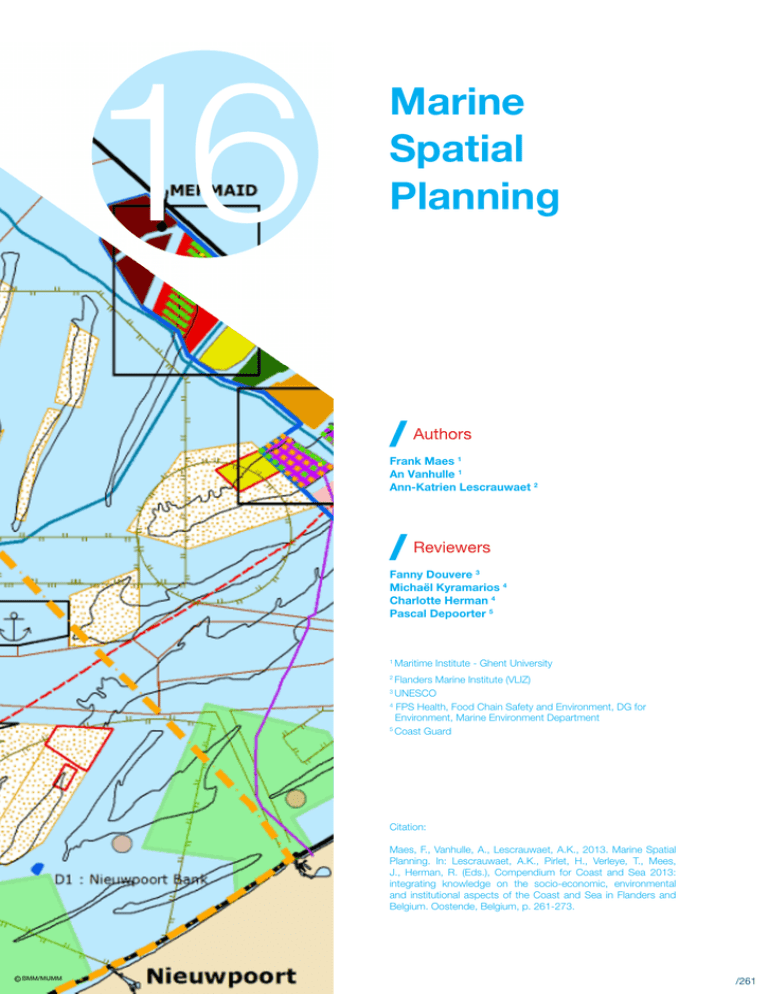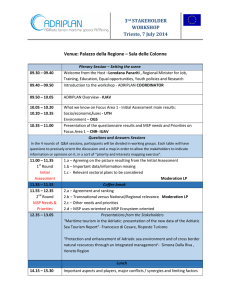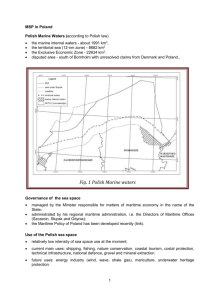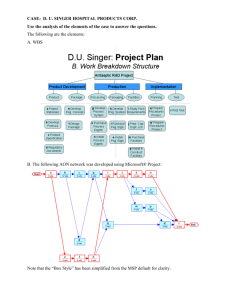16 Marine Spatial Planning
advertisement

16 Marine Spatial Planning / Authors Frank Maes 1 An Vanhulle 1 Ann-Katrien Lescrauwaet 2 / Reviewers Fanny Douvere 3 Michaël Kyramarios 4 Charlotte Herman 4 Pascal Depoorter 5 1 Maritime Institute - Ghent University Flanders Marine Institute (VLIZ) UNESCO 4 FPS Health, Food Chain Safety and Environment, DG for Environment, Marine Environment Department 5 Coast Guard 2 3 Citation: Maes, F., Vanhulle, A., Lescrauwaet, A.K., 2013. Marine Spatial Planning. In: Lescrauwaet, A.K., Pirlet, H., Verleye, T., Mees, J., Herman, R. (Eds.), Compendium for Coast and Sea 2013: integrating knowledge on the socio-economic, environmental and institutional aspects of the Coast and Sea in Flanders and Belgium. Oostende, Belgium, p. 261-273. c BMM/MUMM /261 Maritime/Marine Spatial Planning (MSP) is a planning process during which the public authorities analyse and organise the human activities in marine areas in space and time, in order to achieve ecological, economic and social targets (Ehler & Douvere 2009 140628, COM (2010) 771). MSP offers an instrument and an assessment framework in order to achieve the proposed policy objectives, in the context of the growing demand for marine space. Currently, MSP is being developed in the European Union (EU) Member States, but also in the United States and other regions around the world. In this regard, European and international initiatives, inter alia within the context of the Intergovernmental Oceanographic Commission (IOC) of UNESCO, are trendsetting. Initially, MSP originated from the global need for the demarcation of marine protected areas (MPAs). More recently, the active planning and management of multifunctional spatial use, especially in important conflict areas, receives particular attention due to the developments in offshore wind energy. Over the past few years, the European Commission (EC) has taken the initiative for the legal anchoring of the concept of MSP in European regulation by means of the European Integrated Maritime Policy (IMP) (COM (2010) 771) and has proposed common principles with regard to MSP in the waters of the European Member States. In European regulation (see below), the term ‘Maritime Spatial Planning’ (MSP) is used to stress the holistic approach to the process (roadmap (COM (2008) 791), Action plan (SEC (2007) 1278)) (see below). The sea constitutes approximately 10% of the Belgian territory: 3,457 km² (VLIZ 2010). The maritime sectors of the Belgian economy contribute significantly to national prosperity with a turnover of nearly 15 billion euros (WES 2010 203225 ). The technological progress as well as new societal challenges increasingly put pressure on the available marine space. Belgium was one of the first countries in the EU that drafted a marine spatial plan (the so-called Masterplan North Sea, 2005). The law of 20 July 2012 concerning the organisation of the MSP introduces the concept of MSP in the law of 20 January 1999 concerning the marine environment. The law focuses on the planning process, stakeholder participation, public consultation and the strategic environmental impact assessment (EIA). The law defines the Marine Spatial Plan for Belgium as a plan that organises the desired spatial, three-dimensional and temporal structure of the human activities, based on a long-term vision and by means of clear economic, social and ecological objectives. The law gives a legal character to the marine spatial plan and will be revised every six years. / 16.1 Policy context On an international level, a great deal has been accomplished with regard to the development of legislation and policy in support of MSP (Maes 2008 136406). Since 1990, several efforts and agreements have been made in anticipation of an ecosystem-based approach to the conservation of marine ecosystems, seas and oceans. In this context, MSP is considered an important cornerstone (Rio Declaration, 1992, Convention on Biological Diversity 1992 (CBD), World Summit on Sustainable Development 2002 (WSSD), IOC UNESCO directives on MSP (Ehler & Douvere 2009 140628)). Effective implementation of MSP on an international level has mainly been the result of the decisions of the Conference of the Parties (such as COP VII/11) of the Convention on Biological Diversity (CBD), which emphasised the importance of MSP principles, based on an ecosystem approach. These principles inter alia include integrated management of marine and coastal areas, the application of an EIA for individual projects and a Strategic Environmental Assessment (SEA) for plans and programmes, and the need for an ecologically representative network of MPAs. In October 2007, the EC drafted the main policy lines for the future IMP for the European Union (COM (2007) 575) and the related Action Plan (SEC (2007) 1278), based on a common vision and common principles. This vision is explained in the ‘Roadmap for Maritime Spatial Planning: Achieving Common Principles in the EU’ (COM (2008) 791). With this roadmap, the EC wants to encourage the Member States to apply the principles on a national level, in coordination with a common approach in the regional seas and European waters. The EC also provides guidance for the application of these principles within the guidelines for an integrated approach to maritime policy (COM (2008) 395). For Europe, MSP is an important instrument to realise the objectives of the IMP: it promotes the coordination of the different authority levels and of the various activities that take place in the marine ecosystem. With this approach, Europe wants to manage the maritime activities in an ecosystem-based way. The ecosystem is thus considered as the basis for the management of human activities at sea (see also theme Nature and environment). A few European countries are currently developing MSP following this ecosystem-based approach. These countries include Belgium, the Netherlands, the United Kingdom, Norway and Germany (more information: http://www.unesco-ioc-marinesp.be). In 2011, the EC launched a public consultation to investigate the different options for the promotion and development of MSP and the interaction with Integrated Coastal Zone Management (ICZM, see theme Integrated coastal zone management). On 12 March 2013, the EC approved a proposal for a directive establishing a framework for MSP and ICZM (COM (2013) 133), in view of the further development of the regulation on MSP in the European waters and the alignment of the approaches to MSP and ICZM. /262 In Belgium, two important laws have been approved with regard to MSP, driven by the United Nations Convention on the Law of the Sea (UNCLOS, 1982): • The law concerning the Exclusive Economic Zone (EEZ) of Belgium (law of 22 April 1999) and modifying the law of 13 June 1969; • The law concerning the protection of the marine environment and the organisation of MSP in the Belgian part of the North Sea (BNS) (law of 20 January 1999, modified by the law of 20 July 2012). These laws constitute a framework for decisions with regard to new users of the sea, such as the construction of offshore wind farms, the growing demand for space for submarine cables and pipelines, new types of recreation at sea and the demarcation of MPAs. The construction of offshore wind farms requires a domain concession as well as an environmental permit. This is also the case for submarine cables to transport the electricity generated at sea to shore. In 2003, a policy for the BNS was specifically included in the federal coalition agreement (July 2003), and a federal minister was appointed to coordinate all federal competencies on the BNS. The Minister of the North Sea is also responsible for MSP. Hence, the development of a sustainable vision for the North Sea was placed high on the agenda. The cooperation agreement of 8 July 2005 between the Federal State and the Flemish region concerning the foundation and the collaboration within the structure of the ‘Coast Guard’, ensured an organised framework for the coordination and mutual consultation between the different policy domains with regard to the sea (law of 4 April 2006, Decree of 17 March 2006). The Royal Decree of 7 September 2003 and the Royal Decree of 9 September 2003 introduced a procedure for the acquirement of a licence and the obligation to carry out an EIA for activities covered by article 25 of the law of 20 January 1999. These obligations do not apply to commercial fisheries, (marine) scientific research and shipping. Table 1 includes a list of the activities that are or are not subject to the licence and EIA obligation of the above-mentioned Royal Decrees. Table 1. Activities that, according to the law of 20 January 1999, are subject or not subject to a licence or EIA obligation. Note: the specific ‘sectoral’ legislation is discussed in more detail in the respective themes of Chapter 2. SUBJECT TO THE LICENCE AND EIA OBLIGATION NOT SUBJECT TO THE LICENCE AND EIA OBLIGATION Civil engineering projects Commercial fisheries Trenching and raising of the seabed (Marine) scientific research The use of explosives and acoustic devices with a high power Shipping The abandonment and destruction of shipwrecks and sunken ship cargoes Activities that are necessary for the execution of matters of the Flemish Region Industrial activities Individual activities without profit Activities mentioned in the Law of 13 June 1969 Publicity and trade associations activities (a part of which is covered by a simplified procedure) Licenses and EIAs ensure the alignment of the different user functions in the North Sea. In order to obtain a licence, the applicant needs to draw up an environmental impact report together with the application. This report estimates the impact of the proposed activity and proposes alternatives if need be. On the basis of this report and the application, the Management Unit of the North Sea Mathematical Models (MUMM) (RBINS) makes an EIA. This EIA is the scientific advice of the licence application. The advice is forwarded to the Marine Environment Department of the FPS Health, Food Chain Safety and Environment. The latter department can also add its advice. Subsequently, the application is delivered to the competent minister who makes a final decision. In the national legislation, marine sand and gravel extraction is covered by the law of 13 June 1969 that regulates the exploration and the exploitation of the non-living resources of the territorial sea and the continental shelf. The geographical demarcation and the accessibility of the zones where exploration and exploitation of the mineral and other non-living resources of the territorial sea and the continental shelf can take place, are stipulated in the Royal Decree of 1 September 2004 - procedure and are also governed by the Royal Decree of 1 September 2004 - EIA (specific ‘sectoral’ legislation is discussed in detail in the respective themes of Chapter 2, see themes Sand and /263 gravel extraction, Dredging and dumping). The Royal Decree of 11 April 2012 (in implementation of the law of 13 June 1969), delimits safety zones around artificial islands, installations and devices for power generation from water, currents and the wind in the BNS. Belgium has already completed an important trajectory concerning MSP. In 2003, Belgium was one of the first Member States with an operational spatial plan for the marine areas, including the territorial sea and the EEZ. The ‘Masterplan North Sea’ (2003-2005) mainly originated from the demand for clear delimitations for the installation of offshore wind farms and MPAs (Douvere et al. 2007 221555). In the Masterplan, the minister of the North Sea established some of the main tasks of his policy, such as the construction of a wind farm at the Thornton Bank, the demarcation of MPAs, enhanced monitoring and prosecution in case of oil pollution at sea (‘zero tolerance policy’), and a policy plan for sustainable sand and gravel extraction. The ‘Masterplan North Sea’, which may be considered as the first spatial plan for the BNS, has been gradually implemented since 2003, and has led to a zoning system for sand and gravel extraction in new management areas. In this regard, a sequential rotation system has been used for the most intensively exploited zones, zones which are temporarily closed during the spawning season of fishes, and an exploration zone where research is conducted to investigate potential future extraction. Furthermore, work has also been done on the multifunctional use of the sea, the protection of wrecks from both an archaeological and ecological perspective, a seaward extension of the terrestrial protected area in Knokke-Heist and the demarcation of zones for research on alternative fishing methods. The Masterplan was a static plan that was not embedded in a framework with a vision for the future, a specific policy framework and an organised planning process (Belpaeme et al. 2011 209076). The GAUFRE project (GAUFRE project BELSPO) developed alternative scenarios for a spatial structure plan for the BNS (Maes et al. 2005 78467). This policypreparing research produced breakthrough results that have been a source of inspiration far beyond Belgium. With only 3,457 km² and a potential use of 260% of the available space, Belgium faces an important challenge. An area with numerous intensive maritime user functions such as the BNS, requires a detailed MSP process (Belpaeme et al. 2011 209076). The BNS can also serve as an example for the implementation of the IMP, in particular in the European maritime areas with intensive spatial use. The subsequent ministers for the North Sea further shaped the policy concerning the North Sea (table 2) and in 2009, MSP was put back on the agenda (Policy Document Marine Environment 2009 225442). The MSP initiative was coordinated by the Marine Environment Department. With the appointment of the new federal Minister of Economy, Consumers and the North Sea in 2011, a new marine spatial plan was announced in the Policy Document Economy, Consumers and the North Sea 2011 226536 which takes into account: • The possible delimitation of a new area for wind turbines; • The possible development of offshore renewable energy sources other than wind energy; • The possibility to create cross-border MPAs; • The possible construction of a logistic platform for sea shipping. Table 2. Overview of the historical trajectory of the implementation of MSP in Belgium and the interaction with the developments on the European level. YEAR /264 POLICY INSTRUMENT OBJECTIVE/REFERENCE TO MSP OR ASPECTS OF THE MSP PROCESS 2003 Masterplan North Sea First spatial plan for the BNS 2003-2004 Policy document of the FPS Mobility and Transport of the minister of Mobility and Social Economy 2004 226534 Development of a longtermvision for the North Sea, based on the sustainable management of shipping and the coordination of the different competencies on the North Sea policy (emergency response, licences and concessions) 2004-2005 Policy document Mobility 2004 226529 No reference to the North Sea policy 2005-2006 Policy document of the minister of Mobility 2005 226530 (Title 3.8): monitoring of the voluntary agreements with the recreational users of the sea in the context of the protected marine reserve ‘Baai van Heist’ and the Birds and Habitats Directive areas; monitoring of the planned implementations such as the protection of wrecks with an important archaeological value. 2006 Green Paper - Towards a future Maritime Policy for the Union: A European Vision for the Oceans and Seas (COM (2006) 275) MSP for the first time on the European political agenda YEAR (continuation) POLICY INSTRUMENT OBJECTIVE/REFERENCE TO MSP OR ASPECTS OF THE MSP PROCESS 2006-2007 Policy document of the minister of Mobility 2006 226531 (Title 3.8): the sustainable implementation of the Masterplan concerning sand extraction, concessions of wind farms, consultation with the Netherlands with regard to the demarcation of Vlakte van de Raan, the demarcation of zones for the protection of wrecks with an important archaeological value. 2007 Communication of the EC on an IMP for the EU and a Roadmap/action plan (COM (2007) 575 and SEC (2007) 1278) ‘Blue paper’ refers to MSP as a cornerstone for the European IMP. 2007-2008 Policy document of the prime minister concerning the Marine Environment 2008 226532 DOC 52 0995/015 (2007/2008) (Title 3.1) Reference to the demand for marine space and the need for sustainable development and impact assessment, and the drafting of a marine cadastre, (title 3.2) the drafting of policy plans for the MPAs that were designated in 2005. Monitoring of the quality of the marine environment and prevention of and protection against marine pollution. 2008-2009 Policy document of the prime minister concerning the Marine Environment 2008-2009 226533 (Title 3.1) Simplification of the licence procedures and environmental impact reporting, the initiation of consultation with the users and the authorities involved in anticipation of an integrated and balanced spatial planning policy in the BNS. 2008 Roadmap to maritime spatial planning. Communication of the Commission (COM (2008) 791) Proposal of the EC for the application of common principles on MSP in the EU. 2009-2010 Policy document Marine Environment 2009 225442 DOC 52 2225/023 Refers to the masterplan of 2003 and to an extension of this masterplan with inter alia a sustainable transport policy in the Belgian EEZ, the reform of the existing demarcation for offshore wind energy, taking into account an integrated vision for the marine environment. 2009-2010 Policy document Marine Environment 2009 225442 DOC 52 2225/024 Refers to 4 policy pillars for a sustainable policy in the BNS and the importance of the Marine Strategy Framework Directive (2008/56/EC) (MSFD) as a milestone for the implementation of the MSP. Highlights the necessity for a renewed MSP and the commitment to deliver a significant contribution to a new MSP process, and to keep this process high on the agenda. 2010 Decision of the EC (01/09/2010) in implementation of the MSFD (2010/477/EC) Annex part A (title 6) and part B (descriptive element 7) refer to MSP as an instrument supporting an ecosystem-based approach, the evaluation of the size and the cumulative aspects of the impact of human activities and for the achievement of a good environmental status in the MSFD. 2010 Communication of the EC on the MSP in the EU (COM (2010) 771) Situation and new insights with regard to MSP in Europe, the relation of MSP to other policy instruments (Common Fisheries Policy, MSFD, ICZM), and the future perspective for MSP in Europe and the regional seas. 2011 EU Regulation establishing a Programme to support the further development of an Integrated Maritime Policy (1255/2011/EC) Establishes a programme to support the further development of the IMP. 2011 Policy document Economy, Consumers and the North Sea 2011 226536 Announcement of a new marine spatial plan for the BNS. 2012 Amendment of the law of 20 January 1999 Legislative base for the marine spatial plan and the legally binding character, a review every 6 years. 2012 Royal Decree in implementation of the MSP An advisory commission and a procedure for the adoption of the marine spatial plan in the BNS. 2013 The draft of the Marine Spatial Plan (Ontwerp van koninklijk besluit tot vaststelling van het marien ruimtelijk plan, 2013 227527) Public consultation based on the draft of the Marine Spatial Plan (Ontwerp van koninklijk besluit tot vaststelling van het marien ruimtelijk plan, 2013 227527) and the associated SEA (Milieueffectenrapport van het ontwerp van marien ruimtelijk plan, 2013 227526). Milieueffectenrapport van het ontwerp van marien ruimtelijk plan, 2013 227526 /265 The zoning in the Masterplan was not legally anchored as an integral plan: the different zones were indicated by different Royal Decrees. A procedure was lacking to give the plan a legal status and therefore it was not possible to modify or evaluate it timely. The law of 20 July 2012 introduces the organisation of the MSP into the law of 20 January 1999 concerning the protection of the marine environment. The law focuses on the planning process, stakeholder participation, public consultation and the strategic EIA. This law attributes a legally-binding character to the marine spatial plan. The procedure for the marine spatial plan is established by the King by means of a Ministerial Council decision. The marine spatial plan is also set by the king, with a decision of the council of ministers. The plan is evaluated every six years and adapted if need be, but the King can also insert an interim modification procedure. Finally, by means of the Royal Decree of 13 November 2012, an advisory commission was established by the King. At the moment (September 2013), public consultation is taking place based on the draft of the Marine Spatial Plan (Ontwerp van koninklijk besluit tot vaststelling van het marien ruimtelijk plan, 2013 227527) and the associated SEA (Milieueffectenrapport van het ontwerp van marien ruimtelijk plan, 2013 227526). / 16.2 Spatial use The many involved actors and authorities that claim the use of (a part of) the BNS, evolved in the need for MSP. The original Masterplan North Sea (2003) was drafted on an ‘ad hoc’ basis, taking into account the different sectoral regulations. This way, consultation with other users of the sea was not always necessary in case of modifications. Given the growing demand for marine space over the past few years, with the demarcation of MPAs, the zones for offshore wind energy, new concession zones for sand extraction, etc., the ‘ad hoc’ model seemed to have reached its limits. The BNS is, in compliance with the UNCLOS Convention, divided into five marine zones, each with a different legal character (Maes & Cliquet 1997 24406, Somers 2004 143607). These zones are: the territorial sea, the contiguous zone, the continental shelf, the fisheries zone and the exclusive economic zone (EEZ) (the last three zones have the same geographical delimitation). The continental shelf only concerns the exploration and the exploitation of the non-living resources of the seabed and its subsoil, while the EEZ refers to exploration and exploitation of the living and nonliving resources of the water as well as the seabed and the subsoil. A complete overview of the different legal zones of the BNS is given in Maes et al. (2005) 18619 and with regard to the legislation in Maes & Cliquet (2004, 4 parts) 1573 and Somers & Maes (2011) 221400. The zoning plan (Maes et al. 2005 78467, GAUFRE project BELSPO) shows the limitations of the legislative demarcations, the existing nature conservation areas at sea (Natura 2000 and Ramsar areas) and delimits areas for sand and gravel extraction, anchorages and shipping routes, zones for renewable energy, aquaculture, protection of the maritime heritage, military use and other users. A detailed description of the spatial use of each of the user functions is available in the respective themes of Chapter 2. Several research projects have been conducted on the management of spatial use in the BNS1. The GAUFRE project (2003-2005) (GAUFRE project BELSPO) was aimed at establishing the scientific basis to develop a spatial structure plan for the BNS. GAUFRE also initiated a structure plan which takes into account the conflicts between several stakeholders, and active participation of these groups and the general public. The results published in the book ’A Sea of Space’ (Maes et al. 2005 78467, GAUFRE project BELSPO) showed that the potential demand for space was approximately 2.6 times higher than the available space (allocation of space based on the legislation which existed at that moment, and on the condition that this space would be used). Since this study, a significant seaward extension of the former Trapegeer-Stroombank area has been realised. The entire MPA now covers a surface of 1,099.939 km² (an extension of approximately 920 km²) and covers more than a third of the total surface of the BNS. The BWZee project (April 2004 - March 2006) developed a scientifically underpinned methodological framework for the execution of a biological valuation and applied this to the BNS. The final product was a biological valuation map that revealed the relative importance of the entire BNS in terms of natural values and biological diversity for the first time, at least on the basis of an (incomplete) number of relevant taxonomic groups. In the BALANS project (2002-2006) (BALANS project BELSPO), a conceptual policy model was developed that strived for a balance between the social, economic and ecological indicators with regard to a sustainable North Sea policy. The model is considered as support for the marine policy and was tested on real data of shrimp fishing and sand extraction. 1 Other research and monitoring projects that contribute indirectly to MSP, or projects which are not integrative or specifically aimed at the BNS, are discussed in Chapter 1. /266 THE DIFFERENT USERS OF THE BNS Figure 1. An integrated map with the different users of the BNS as included in the draft of the marine spatial plan (Ontwerp van het koninklijk besluit tot vaststelling van het marien ruimtelijk plan, 2013 227527). /267 / 16.3 Societal interest of MSP (Adapted from the Position paper on MSP, Belpaeme et al. 2011 209076). MSP offers a legal procedure and an assessment framework to achieve the policy goals on the economic, social and ecological level for the BNS, in the context of the growing demand for marine space. The societal benefits of MSP are mainly situated in the following aspects: • A transparent framework for a spatial and temporal alignment of the (co-)users and (co-)user functions in the BNS, in the land-sea transition zone as well as in the border areas; • A legal framework that allows the government, investors and operators to plan investments and initiatives more efficiently in the long term; • Support of an ecosystem-based approach to management at sea, with attention to the carrying capacity of the marine environment; • A platform for the alignment of the competent authorities (including the sectoral legislation and licence procedures) with a centralised licence policy and clear procedures; • A platform for the integration of scientific knowledge and information in the policy and decision-making processes; • A monitoring and evaluation system supporting an adaptive policy and management; • A vision for the future that includes the social and economic needs and benefits in the long term. (adapted from Belpaeme et al. 2011 209076) An exhaustive explanation of the societal benefits of MSP, as well as an overview of the MSP processes in Belgium, in the neighbouring countries or on a worldwide scale (including reference material) can be found in Dahl et al. (2009) 140628 , Douvere (2010) 195891 and Belpaeme et al. (2011) 209076. The MESMA project (EU FP-7, 2010-2014) intends to develop an instrument for the alignment of various aspects of the spatial management of the marine environment in Europe. The BNS is included as a case study in the project. The elaboration of an ‘open’ data system with information on (1) the distribution of marine habitats and species, (2) economic values and benefits and (3) human activities and effects is an important aspect in this context. This database should constitute an interface between science, politics and policy-makers. / 16.4 Current status Belgium is working on an integrated maritime spatial use plan and planning process. An SEA of the draft marine plan concerning the impact of an MSP process in the BNS is currently open for public consultation (Milieueffectenrapport van het ontwerp van marien ruimtelijk plan, 2013 227526). The concept of MSP has been discussed in several national and international organisations, working groups and societal think-tanks. These exercises offer interesting perspectives and challenges that can be taken into account during the current preparation of the MSP process in the BNS (table 3). Table 3. Initiatives and processes preparing MSP with regard to the BNS. INITIATIVE /268 PRODUCT (2003-2005) GAUFRE project (GAUFRE project BELSPO) The GAUFRE project developed the scientific basis and initiated a spatial structure plan for the BNS, including conflict analysis and participation. The results were aggregated in the publication ‘ A Sea of Space’ (Maes et al. 2005 78467). (2008) Private enterprises “Flanders bays 2100” A consortium of Flemish dredging companies and consultants proposed ‘Flanders Bays 2100’ as a vision for a sustainable future of the coast. The Flemish government investigated the feasibility of the project and its subprojects. (2009) Spatial designers: Office for Metropolitan Architecture (OMA) The Masterplan Zeekracht of the OMA thought about the possible location of windmills in the North Sea, and about the creation of new space for multifunctional use. (2009-2010) MARIPAS project: shared spatial use of fisheries and energy production in the BNS A feasibility study for the development of fisheries and aquaculture in offshore wind farms: an overview of the opportunities and restrictions with regard to fisheries and mariculture, the regulation and the opinion of all stakeholders; explore opportunities to link sustainable fisheries / mariculture in the long term to sustainable energy production in the BNS in order to realise an additional commercial value. INITIATIVE (continuation) PRODUCT (2010-2011) The ad-hoc working group MSP, composed of independent experts, academics and scientists, aiming to formulate recommendations with regard to MSP in Belgium An inventory of MSP in Belgium 221481 based on the UNESCO guide for MSP (Ehler & Douvere 2009 140628). A position paper (Belpaeme et al. 2011 209076) that discusses the future approach to MSP. The task force is established by the Coordination Centre for ICZM in the context of the C-scope project. (2009-2012) C-scope project: combining sea and coastal planning in Europe (INTERREG 2 Seas Programme) A final report with the experiences of the project concerning integrated planning on land and at sea, based on two case studies in the Baai van Heist nature reserve (Belgium) and Dorset (UK). In these case studies, the way in which land and sea planning can be linked was investigated. (2009-2013) MESMA project: Monitoring and Evaluation of Spatially Managed marine Areas (EU FP7 Programme) European collaboration and alignment of MSP and the development of integrated management tools (concepts, models, directives) for monitoring, evaluation and implementation of MSP in marine areas. Includes a case study in the southern part of the North Sea. (2010) Spatial designers: Spatial manifest, M.U.D. (multi-user-dimension) FLC – an independent association of designers, urbanists and artists – opened a debate on planning in the coastal zone in order to develop a proactive image of the coast. FLC started from a scenario of sea level rise. The final product was graphic work (exhibition, video, leaflet, etc.). (2010) Architects and spatial planners Charlotte Geldof and Nel Janssens A critical essay concerning spatial planning at sea: MSP – developing a critical vision and the importance of the commons (Geldof & Janssens 2010 199919 ). (2010-2012) The MASPNOSE project (EU cofinancing) Test project on MSP in the North-Eastern Atlantic Ocean with partners from the Netherlands, Belgium, Germany and Denmark, aiming to gain experience in the implementation of cross-border MSP. There were two study areas: the Dogger Bank and the Belgian-Dutch border at the Thornton Bank. MASPNOSE initiated a dialogue between Belgian and Dutch MSP experts and offered the basis for a potential Dutch wind energy zone that is connected to the Belgian offshore wind energy zone. (2010-2011) TransMasp (Transboundary Maritime Spatial Planning) project (Marie Curie Fellowship) TransMasp conducted a scientific analysis of the cross-border aspects of MSP as well as the interaction with spatial planning on land for a case study in the French-Belgian marine areas and coastal zone (Nord-Pas-de-Calais and the Belgian coastal zone). (2012) Flanders Bays. Towards an integrated vision for the coast (Flemish Government). The project Flanders Bays 222799 develops a future vision for the Flemish coast and benchmarks the feasibility of future projects in relation to five pillars: safety, sustainability, naturalness, attractiveness and development. / 16.5 Sustainable use 16.5.1 Sustainable management of the human activities at sea MSP will have an impact on the success of a number of other policy domains as well. The European Marine Strategy Framework Directive (2008/56/EC) (MSFD) constitutes the basis for the carrying capacity of the marine ecosystem. This is the environmental pillar of the IMP which also offers a framework for the economic potential. A Good Environmental Status (GES) has to be achieved and maintained and all relevant human activities need to be executed in coordination with the required protection and conservation of the marine environment as well as in coordination with the concept of sustainable use of marine goods and services. The legal implementation of the MSFD in the national legislation is a cornerstone for the further elaboration and coordination of MSP in the BNS. Besides the legal transposition (Royal Decree of 23 June 2010), the following projects were commissioned in the period 2010-2012: an initial assessment of the status of the marine environment (2012) 220230, an analysis of the pressures, influencing factors and human activities, a socio-economic analysis of the users of the BNS (2012) 220231 and an analysis of the costs related to the destruction of the marine environment. Moreover, a description of the GES and the Environmental Goals 220232 has been drafted. These elements contribute directly to the definition of the GES (July 2012) which will be used to benchmark marine activities from 2012 onwards. The implementation of the MSFD and the definition of the GES thus constitute the basis for an ecosystem-based /269 approach to the sustainable use of the marine environment. The implementation of the MSFD also requires integration and adaptation of the existing specific regulations, if need be. In this context, certain elements of the Water Framework Directive (2000/60/EC) (WFD) that are valid in the marine waters were explicitly incorporated in the regulation. Finally, the BNS is a limited marine area that is fully surrounded by the EEZs of the neighbouring Member States. Hence, the sustainable use of space and the drafting of a long-term vision for marine spatial use are significantly influenced by the policy choices and management of the marine areas of the surrounding Member States. Therefore, cross-border consultation and alignment with the MSP in the border regions is taking place within the scope of the current legislation. On 12 November 2009, the United Kingdom approved the UK Marine and Coastal Access Act. This law offers a framework for MSP. The Marine and Coastal Access Act also includes the foundation of the Marine Management Organisation (MMO) (1 April 2010), a cross-sector body for the planning, regulation and licensing of marine activities with a focus on sustainable development. In 2011, the MMO started with the first of eleven regional maritime spatial plans which also contained a cross-border component. In 2008, the Netherlands expanded the Dutch law on Spatial Planning towards the EEZ. In parallel with this law, the existing maritime spatial plan for the Dutch part of the North Sea was revised. Moreover, the revised maritime spatial plan was integrated into the Dutch National Waterplan 2009-2015 205141 . This also includes the spatial management of the coastal zone, estuaries and rivers. The visionary ‘integrated management plan North Sea 2015’ introduces an integrated evaluation framework for all activities subject to a licence obligation. Until 2005, maritime spatial plans in France were covered by the central government. Since 2005, the local authorities can also initiate and develop maritime spatial plans. The approach is based on the principles of planning on land, using schémas de cohérence territoriale (SCOT), offering local coastal authorities the possibility to join. The Façades Maritimes constitute the cornerstones of the maritime policy. An approach has been developed, based on the marine activities and their connection to the land (Queffelec & Maes 2013). More information on MSP worldwide is available on the following website: http://www.unesco-ioc-marinesp.be/msp_around_the_world. /270 / Legislation reference list Table with international agreements, conventions, etc. INTERNATIONAL AGREEMENTS, CONVENTIONS, ... Abbreviations (if available) Year of conclusion Title Year of entering into force Ramsar Convention Convention on Wetlands of International Importance especially as Waterfowl Habitat 1971 1975 UNCLOS United Nations Convention on the law of the Sea 1982 1994 Table with European legislation. The consolidated version of this legislation is available on Eurlex. EUROPEAN LEGISLATION Abbreviations (if available) Title Year Number Directives Water Framework Directive Directive 2000/60/EC establishing a framework for Community action in the field of water policy 2000 60 Marine Strategy Framework Directive Directive 2008/56/EC establishing a framework for Community action in the field of marine environmental policy (Marine Strategy Framework Directive) 2008 56 Regulation establishing a Programme to support the further development of an Integrated Maritime Policy 2011 1255 Communication from the Commission - Towards a future Maritime Policy for the Union: A European Vision for the Oceans and Seas 2006 275 Communication from the Commission - An Integrated Maritime Policy for the European Union 2007 575 Commission staff working document (SEC) - An Integrated Maritime Policy for the European Union 2007 1278 Communication from the Commission - Guidelines for an integrated approach to maritime policy: towards best practice in integrated maritime governance and stakeholder consultation 2008 395 Communication from the Commission - Roadmap for Maritime Spatial Planning: Achieving Common Principles in the EU 2008 791 Commission Decision of 1 September 2010 on criteria and methodological standards on good environmental status of marine waters 2010 477 Communication from the Commission - Maritime Spatial Planning in the EU - achievements and future development 2010 771 Proposal for a directive of the European Parliament and of the Council establishing a framework for maritime spatial planning and integrated coastal management 2013 133 Regulations Other (Decisions, Communications, White Papers, etc.) IMP /271 Table with Belgian and Flemish legislation. The consolidated version of this legislation is available on Belgisch staatsblad and the Justel-databases. BELGIAN AND FLEMISH LEGISLATION Date Title Laws Wet van 13 juni 1969 Wet inzake de exploratie en exploitatie van niet-levende rijkdommen van de territoriale zee en het continentaal plat Wet van 20 januari 1999 Wet ter bescherming van het mariene milieu en ter organisatie van de mariene ruimtelijke planning in de zeegebieden onder de rechtsbevoegdheid van België Wet van 22 april 1999 Wet betreffende de exclusieve economische zone van België in de Noordzee Wet van 4 april 2006 Wet houdende instemming met het Samenwerkingsakkoord van 8 juli 2005 tussen de federale Staat en het Vlaamse Gewest betreffende de oprichting van en de samenwerking in een structuur Kustwacht Wet van 20 juli 2012 Wet tot wijziging van de wet van 20 januari 1999 ter bescherming van het mariene milieu in de zeegebieden onder de rechtsbevoegdheid van België, wat de organisatie van de mariene ruimtelijke planning betreft Royal Decrees KB van 20 maart 2000 Koninklijk besluit ter definiëring van de procedure voor machtiging van het storten in de Noordzee van bepaalde stoffen en materialen KB van 12 augustus 2000 Koninklijk besluit tot instelling van de raadgevende commissie belast met de coördinatie tussen de administraties die betrokken zijn bij het beheer van de exploratie en de exploitatie van het continentaal plat en van de territoriale zee en tot vaststelling van de werkingsmodaliteiten en – kosten ervan KB van 20 december 2000 Koninklijk besluit betreffende de voorwaarden en de procedure voor de toekenning van domeinconcessies voor de bouw en de exploitatie van installaties voor de productie van elektriciteit uit water, stromen of winden, in de zeegebieden waarin België rechtsmacht kan uitoefenen overeenkomstig het internationaal zeerecht KB van 12 maart 2000 Koninklijk besluit betreffende de nadere regels voor het leggen van elektriciteitskabels die in de territoriale zee of het nationaal grondgebied binnenkomen of die geplaatst of gebruikt worden in het kader van de exploratie van het continentaal plat, de exploitatie van de minerale rijkdommen en andere niet-levende rijkdommen daarvan of van de werkzaamheden van kunstmatige eilanden, installaties of inrichtingen die onder de Belgische rechtsmacht vallen KB van 7 september 2003 Koninklijk besluit houdende de procedure tot vergunning en machtiging van bepaalde activiteiten in de zeegebieden onder de rechtsbevoegdheid van België (vergunningsbesluit) KB van 9 september 2003 Koninklijk besluit houdende de regels betreffende de milieueffectenbeoordeling in toepassing van de wet van 20 januari 1999 ter bescherming van het mariene milieu in de zeegebieden onder de rechtsbevoegdheid van België (MEB-besluit) KB van 1 september 2004 – toekenningsprocedure Koninklijk besluit betreffende de voorwaarden, de geografische begrenzing en de toekenningsprocedure van concessies voor de exploratie en de exploitatie van de minerale en andere niet-levende rijkdommen in de territoriale zee en op het continentaal plat (vergunningsbesluit) KB van 1 september 2004 – milieueffectenbeoordeling Koninklijk besluit houdende de regels betreffende de milieueffectenbeoordeling in toepassing van de wet van 13 juni 1969 inzake de exploratie en exploitatie van niet-levende rijkdommen van de territoriale zee en het continentaal plat (MEB-besluit) KB van 23 juni 2010 Koninklijk besluit betreffende de mariene strategie voor de Belgische zeegebieden KB van 11 april 2012 Koninklijk besluit tot instelling van veiligheidszones rond de kunstmatige eilanden, installaties en inrichtingen voor de opwekking van energie uit het water, de stromen en de winden in de zeegebieden onder Belgische rechtsbevoegdheid KB van 13 november 2012 Koninklijk besluit betreffende de instelling van een raadgevende commissie en de procedure tot aanneming van een marien ruimtelijk plan in de Belgische zeegebieden Decrees Decreet van 17 maart 2006 /272 Decreet houdende instemming met het samenwerkingsakkoord van 8 juli 2005 tussen de federale Staat en het Vlaamse Gewest betreffende de oprichting van en de samenwerking in een structuur Kustwacht. BELGIAN AND FLEMISH LEGISLATION (continuation) Date Title Other Samenwerkingakkoord van 8 juli 2005 Samenwerkingsakkoord tussen de federale Staat en het Vlaamse Gewest betreffende de oprichting van en de samenwerking in een structuur Kustwacht /273








